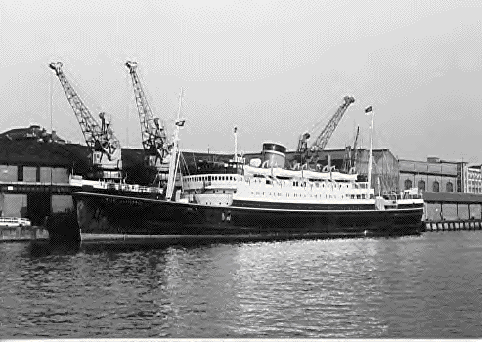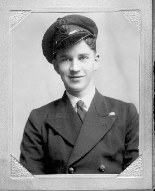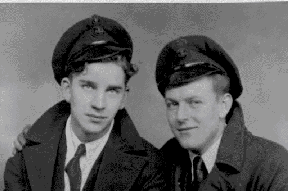www.DarbyRangers.Com Follow Me
HMS Royal Ulsterman
Freddie Robertson Memorial Page
 |
THIS IS A HISTORY OF (LSI) H.M.S. ROYAL ULSTERMAN AS REMEMBERED BY: MR. G.H. SAUNDERS
LSI(H) ROYAL ULSTERMAN 1942-1945 : Sailed from Penarth South Wales Sept. 1942 destination Greenock, started manoeuvres on Loch Fyne with 1st. Battalion American Rangers and British Army Commandos. Exercise finished October 1942, stored ship in Gourock. Sailed with invasion fleet 3rd. Week of October 1942 to North Africa, said to be the largest convoy of all time.
Following is a quote from Ranger Seymour Miller who sailed on H.M.S. Royal Ulsterman in Invasion fleet to North Africa:
"Yes Steve, I was one of your Dads "Tough Cookies" and I do remember the Royal Ulsterman. I was on board her for over twenty days enroute to Arzew, North Africa. I have several memories of this trip, first and foremost was being seasick for the first time in my life. The seas were extremely rough and it was my understanding that to make this ship capable of going into shallow waters for invasion purposes, part of the keel was removed. This of course made it bounce around like a cork...I believe the Ulsterman was originally a channel ferry. I specifically remember one day when I was on deck tossing my "cookies" and watching as a wave, like a giant hand grabbed a landing craft and left it hanging by just one davit A second hand reached up and finished the job. Another rough weather incident that stands out in my mind is the night I drew guard duty at the foot of the grand stairway that went up to the officer's mess. A Navy officer on his way up to the dining room offered to get me something to eat. A few minutes later he returned with a sardine sandwich. After one bite, I decided I wasn't hungry and was trying to decide what to do with the sandwich in one hand and the rifle in the other. At that moment what I thought was my saviour came down the steps in the form of a cat. I offered the lovely sandwich to him and after one sniff and a meow the cat went on his way. I think the cat was just as sick as I was. Next day I heard the cat had died. Another first for me was sleeping in a hammock. We were set up in what during the day was the enlisted men's mess. The hammocks were good for sleeping but bad for trying to get into. Another advantage to being near the kitchen was the delicious aroma of mutton stew. It was cooked all night in what I believe was Diesel oil. Actually the whole ship smelled of diesel oil. We did however, envy your dad and his shipmates when they lined up with their tin cups for the ritual of the doling out the ration of Rum...it was something to see. I'm sorry to bore you with this wordy essay, but there's not much I remember from those days and when I do, I can't stop talking about it. Sorry I couldn't specifically remember Freddie Robertson, but I would like to believe he was the nice young chap that recommended dry bread for seasickness…it helped."
Seymour Miller 6th January 2001
Landed 1st Battalion American Rangers assault troops on beaches at Arzew, port south of Algiers at 2 a.m. 7th. of November 1942. There was very little action through the night but in the morning some air attacks by Vichy French aircraft. These caused no damage and were soon fought off. After The Rangers had consolidated their positions on the beaches we sailed to Algiers companioned by the Royal Scotsman, Ulster Monarch, Queen Emma and Princess Beatrix. Our task was to ship troops from Algiers first to Bougie then Phillipville and Bone, as the Germans retreated, and meet up with the eighth army in Tunisia.
The five ships were nicknamed " The Moonlight Squadron " and the route up the North African coast was to be known as "dive bomb alley" as we were greeted by stukas on every voyage. After the fall of Tunisia we moved on to that country and operated from the ports of Souse and Sfax.
Then was the preparation for the invasion of the island of Pantelleria we took on board the lads of the Eighth Army they wasn't very happy about it because they had already fought right through the western desert with Monty. The landing was very quiet, 10.00 a.m., in the morning early in 1943, Although we did hit trouble late afternoon after our escorts of cruisers and destroyers left. We were dive bombed by stukas flying in from Sardinia. We destroyed 3 of them ( our best single bag throughout the war ).That invasion was very easy compared to the rest of the landings.
The next exercise was the preparation for the invasion of Sicily in 1943. The preparation was not too difficult because we were already invasion trained in previous actions. Before we left Sfax to join the Sicily Invasion force Lord Louie Mountbatten, then commander of Combined Operations, came aboard and gave us a pep talk. He also got all of our mail sent from FMO Gibraltar before we sailed. We had received no mail for over 6 weeks prior to that.
There was fierce opposition where we landed, on the southern tip of Sicily (Porto Paolo). On that operation the Royal Ulsterman was H.Q. Ship directing movements of landing craft and personnel. The German defences were very strong but with sea and air bombardment the difficulties were overcome. After the troops established a beachead and got a foothold they managed to move inland. We then sailed for Malta and there stayed for 3 weeks. Then back to Tunisia for a spell, then to Tripoli. Meanwhile Sicily was captured and the Army had advanced into Southern Italy, an operation we were not involved in. Later we were engaged in some more troop carrying from Sicily into Italy. On one of these trips we struck a wreck in Taranto Bay and damaged a propeller. We returned to the U.K. via Belfast, to pick up a new screw, and then to Mount Stewart dry dock in Cardiff repairs were carried out. In the four weeks we were there the people of Tiger Bay adopted the Ship and they were eventually presented with our Battle Ensign as a gesture for their hospitality to the Ship's company.
We then returned to the Mediterranean ( Algiers ) to prepare for the Salerno landings. We thought that it was going to be fairly easy because the Italians had capitulated the day before the landings. We started off heading north, towards Naples, turning south at midnight towards Salerno, to fool any German air or sea patrols but it didn't work out !
German aircraft picked up our positions as we steered south at midnight. The Germans had also taken over the shore defences from the Italians so by the time we landed at Salerno they were ready and waiting! It turned out to be a rough ride getting the assault troops ashore and it was quite a battle for them just to get off the beaches. We had to stand by to evacuate. Consequently the back up forces were bought in earlier than intended and sorted matters out, but it was very busy for a few days what with bombing and shelling from shore batteries. We were glad when we finished our bit towards the invasion of Salerno.
Things eased off for a while and we had some shore leave in Algiers. Then we did a couple of commando raids along the Italian coast and one job as a decoy ship. We sailed close to the coast to attract gunfire from German shore positions, once the guns `flashed' The Nelson, Rodney and 2 cruisers then bombarded them from about 10 miles out.
Following is a quote from Ranger Jud Luckhurst who was landed at Anzio beachhead:
"Steve, I was with the Rangers in the landing at Anzio. The two ships that we used were the Royal Ulsterman and the Princess Beatrix. At my age 82 it is hard for me to remember for sure but I think I landed with the Princess Beatrix, they were both the best. After the landing in Sicily where these two ships were not used and where many Rangers drowned because of being let off the landing craft too soon it was rumoured that Col. Darby asked that the Royal Ulsterman and the Princess Beatrix be assigned to him for any further invasions. It was said by many of the Rangers (in admiration not in any disrespect) that if those crazy Limey's had roller skates on the bottoms of their boats they would take us inland. I know that I was only wet up to my knees at Anzio. Some of the older Rangers got to know some of the crew quite well and the crewmembers would even save up their Grog ration for them. They were a good bunch of men and were highly respected by the Rangers. If you know any of the men from either of these two ships please give them my best regards."
Ranger Jud "Lucky" Luckhurst. 5th. January 2001
We then landed troops at The Anzio beachhead, which started in 1944. It started off very quiet because the Germans had retreated. But then they counter attacked and it ended up a bloody battle. Lots of lives were lost including a large percentage of the American Rangers. Everything turned out all right in the end. That was the finish of the Royal Ulsterman's and other LSI's duties in the Med. And we returned home to blighty for a spot of leave and then preparations for D Day "the Big One".
On return to England we docked for 2 days in Greenock, then on to Southampton for some repair work and new assault craft. Then D Day June 6th. 1944. We embarked the assault troops at Berth 37 Southampton Harbour. We sailed from our holding position on the Solent (Area 19E North of East Cowes), at 1600 hours on the 5th. Of June 1944. Our convoy was assault convoy J14 ( J3 Reserve Force under the command of Acting Lt. Commander W.R.K.Clarke D.S.C. RD R.N.R. ). We were on station at our lowering point, ready to winch down the LCA's at 0808 hours on the 6th. We carried troops of The 9th. Brigade of the 3rd. Canadian Division. Comprising of the following regiments :
The Highland Light Infantry of Canada, The Stormont, Dundas & Glengarry Highlanders and The North Nova Scotia Highlanders. A total Assault Force of approximately 400 men. The first of our troops ashore were landed at NAN WHITE ( Berniers-Sur-Mer ) and NAN RED ( St. Aubin-Sur-Mer ) at 1133 hours. These beaches were within an area of JUNO Beach. All troops are recorded ashore by 1150 Hrs. We lost some Army lads when one of our LCA's was hit by gunfire, our Sub-Lieutenant lost his arm. After the landings we were engaged in bringing wounded back to England and shipping more troops to France, this lasted quite a long period. After that it was easy going to de-mob. LSI(H) Royal Ulsterman came through with flying colours, just showed signs of her old age.



Ship Mates Left to Right; Freddie Robertson/Ships Cook; and Unknown Crew Members
IT WAS A GREAT HONOUR TO HAVE SERVED WITH S/M FREDDIE ROBERTSON YOUR DAD, AND THE REST OF THE SHIP'S COMPANY ABOARD LSI (H) ROYAL ULSTERMAN.
Signed G. H. SAUNDERS.
HMS Royal Ulsterman Material Used with Permission
HMS Royal Ulsterman Research:
Steve Robertson, DTp. A.D.I.
crosspoint@tiscali.co.uk (Steve Robertson)
DSA Registered LGV Driving Instructor.
http://www.lorrydrivertraining.co.uk/
